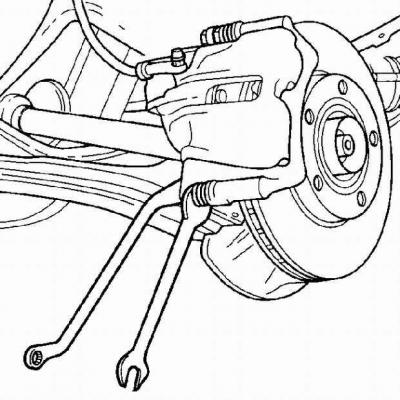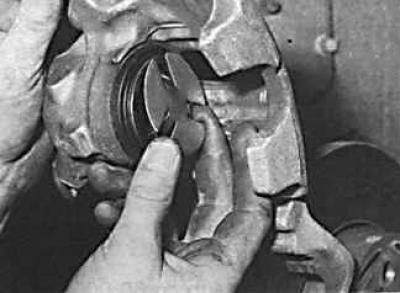Lucas front brake

- 1 - brake hose,
- 2 - clamp,
- 3 - brake pipeline, 15 Nm,
- 4 - self-locking bolt, 30 Nm,
- 5 - bolt, 12 Nm,
- 6 - caliper holder with guide pins and protective covers,
- 7 - brake disc,
- 8 - brake pads,
- 9 - thermal protection plates,
- 10 - support,
- 11 - bracket,
- 12 - bolt, 10 Nm
Warning: When installing bolt 4, a new bolt must be used. When unscrewing the bolt, it is necessary to keep the guide pin from turning.
Warning: Before installing bolt 5, the ribbed surface at the base of the bolt head must be cleaned.
Warning: Bracket 11 is screwed to the caliper.
Warning: When installing brake pads, a new guide pin bolt must be used.
Removing

1. Remove the lower guide pin bolt. At the same time, use a thin wrench to keep the guide pin from turning. Use only a new bolt to secure the guide pin.

2. Rotate the caliper up on the top guide pin and tie it to the upright with soft wire.
3. If the condition of the brake pads allows their further use, clean them using a clean wire brush and rags.

4. Before installing the pads, check that the guide pins move freely in the caliper holder and check that the guide pin rubber boots are not damaged. Clean dust and dirt from the caliper and piston. Check the condition of the dust seal around the piston. Using a metal brush, clean the brake disc from any traces of rust.

5. If new brake pads will be installed, press the piston into the caliper. This can be done using a special tool or a hammer handle. When doing this, make sure that the piston is not warped and that the surfaces of the piston and boot are not damaged. When the piston is pushed in, the brake fluid is forced out of the brake cylinder into the expansion tank, so constantly monitor the fluid level in the tank and, if necessary, pump it out. When installing old brake pads, put them in their original places.

6. Check that the heat shield is properly seated in the piston recess.
7. Insert the outer and inner brake pads into the caliper holder.
8. Lower the caliper onto the brake pads, press the caliper into position, then screw in the guide pin mounting bolt, tightening it to 30 Nm.
9. Check the brake fluid level in the reservoir. It must not exceed the max. Press the brake pedal several times to press the pads against the brake disc, and recheck the brake fluid level in the reservoir
10. Replace the brake pads on the second front wheel in the same way.
11. Install wheels and lower vehicle.
12. Recheck the brake fluid level.
13. After installing new brake pads, they should run in. On the first 200 km of run it is not recommended to make the maximum braking.

Visitor comments